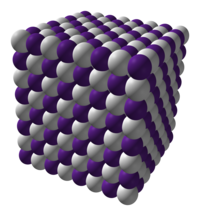Caesium hydride
 |
|
| Names | |
|---|---|
|
IUPAC name
Caesium hydride
|
|
| Other names
Cesium hydride
|
|
| Identifiers | |
|
3D model (Jmol)
|
|
| ChemSpider | |
|
PubChem CID
|
|
|
|
|
|
| Properties | |
| CsH | |
| Molar mass | 133.91339 g/mol |
| Appearance | White or colorless crystals or powder |
| Density | 3.42 g/cm3 |
| Melting point | ~170 °C (decomposes) |
| Structure | |
| Face centered cubic | |
| Octahedral | |
| Related compounds | |
|
Other anions
|
CsF, CsCl, CsBr, CsI |
|
Other cations
|
LiH, NaH, KH, RbH, and all other hydrides |
|
Except where otherwise noted, data are given for materials in their standard state (at 25 °C [77 °F], 100 kPa).
|
|
|
|
|
| Infobox references | |
Caesium hydride (CsH) is a compound of caesium and hydrogen. It is an alkali metal hydride. It was the first substance to be created by light-induced particle formation in metal vapor, and showed promise in early studies of an ion propulsion system using caesium.
The caesium nuclei in CsH can be hyperpolarized through interactions with an optically pumped caesium vapor in a process known as spin-exchange optical pumping (SEOP). SEOP can increase the nuclear magnetic resonance (NMR) signal of caesium nuclei by an order of magnitude.
At room temperature and atmospheric pressure, CsH has the same structure as NaCl.
...
Wikipedia
